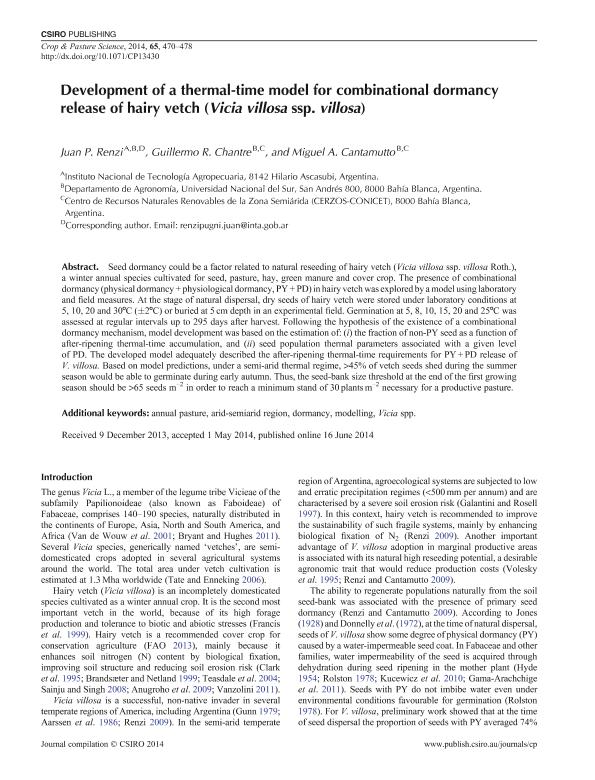Mostrar el registro sencillo del ítem
dc.contributor.author
Renzi, Juan Pablo
dc.contributor.author
Chantre Balacca, Guillermo Ruben

dc.contributor.author
Cantamutto, Miguel A.
dc.date.available
2017-01-16T19:30:20Z
dc.date.issued
2014-06
dc.identifier.citation
Renzi, Juan Pablo; Chantre Balacca, Guillermo Ruben; Cantamutto, Miguel A.; Development of a thermal-time model for combinational dormancy release of hairy vetch (Vicia villosa ssp. villosa); Csiro Publishing; Crop & Pasture Science; 65; 5; 6-2014; 470-478
dc.identifier.issn
1836-5795
dc.identifier.uri
http://hdl.handle.net/11336/11411
dc.description.abstract
Seed dormancy could be a factor related to natural reseeding of hairy vetch (Vicia villosa ssp. villosa Roth.), a winter annual species cultivated for seed, pasture, hay, green manure and cover crop. The presence of combinational dormancy (physical dormancy + physiological dormancy, PY + PD) in hairy vetch was explored by a model using laboratory and field measures. At the stage of natural dispersal, dry seeds of hairy vetch were stored under laboratory conditions at 5, 10, 20 and 30°C (±2°C) or buried at 5 cm depth in an experimental field. Germination at 5, 8, 10, 15, 20 and 25°C was assessed at regular intervals up to 295 days after harvest. Following the hypothesis of the existence of a combinational dormancy mechanism, model development was based on the estimation of: (i) the fraction of non-PY seed as a function of after-ripening thermal-time accumulation, and (ii) seed population thermal parameters associated with a given level of PD. The developed model adequately described the after-ripening thermal-time requirements for PY + PD release of V. villosa. Based on model predictions, under a semi-arid thermal regime, >45% of vetch seeds shed during the summer season would be able to germinate during early autumn. Thus, the seed-bank size threshold at the end of the first growing season should be >65 seeds m–2 in order to reach a minimum stand of 30 plants m–2 necessary for a productive pasture.
dc.format
application/pdf
dc.language.iso
eng
dc.publisher
Csiro Publishing

dc.rights
info:eu-repo/semantics/openAccess
dc.rights.uri
https://creativecommons.org/licenses/by-nc-sa/2.5/ar/
dc.subject
Annual Pasture
dc.subject
Arid-Semiarid Region
dc.subject
Dormancy
dc.subject
Modelling
dc.subject
Vicia Spp
dc.subject.classification
Agronomía, reproducción y protección de plantas

dc.subject.classification
Agricultura, Silvicultura y Pesca

dc.subject.classification
CIENCIAS AGRÍCOLAS

dc.title
Development of a thermal-time model for combinational dormancy release of hairy vetch (Vicia villosa ssp. villosa)
dc.type
info:eu-repo/semantics/article
dc.type
info:ar-repo/semantics/artículo
dc.type
info:eu-repo/semantics/publishedVersion
dc.date.updated
2017-01-13T19:51:10Z
dc.journal.volume
65
dc.journal.number
5
dc.journal.pagination
470-478
dc.journal.pais
Australia

dc.journal.ciudad
Collingwood
dc.description.fil
Fil: Renzi, Juan Pablo. Instituto Nacional de Tecnologia Agropecuaria. Centro Regional Buenos Aires. Estacion Experimental Agropecuaria Hilario Ascasubi; Argentina. Universidad Nacional del Sur. Departamento de Agronomía; Argentina
dc.description.fil
Fil: Chantre Balacca, Guillermo Ruben. Consejo Nacional de Investigaciones Científicas y Técnicas. Centro Científico Tecnológico Bahía Blanca. Centro de Recursos Naturales Renovables de la Zona Semiárida(i); Argentina. Universidad Nacional del Sur. Departamento de Agronomía; Argentina
dc.description.fil
Fil: Cantamutto, Miguel A.. Universidad Nacional del Sur. Departamento de Agronomía; Argentina. Consejo Nacional de Investigaciones Científicas y Técnicas. Centro Científico Tecnológico Bahía Blanca. Centro de Recursos Naturales Renovables de la Zona Semiárida(i); Argentina
dc.journal.title
Crop & Pasture Science

dc.relation.alternativeid
info:eu-repo/semantics/altIdentifier/url/http://www.publish.csiro.au/CP/CP13430
dc.relation.alternativeid
info:eu-repo/semantics/altIdentifier/url/http://dx.doi.org/10.1071/CP13430
Archivos asociados
